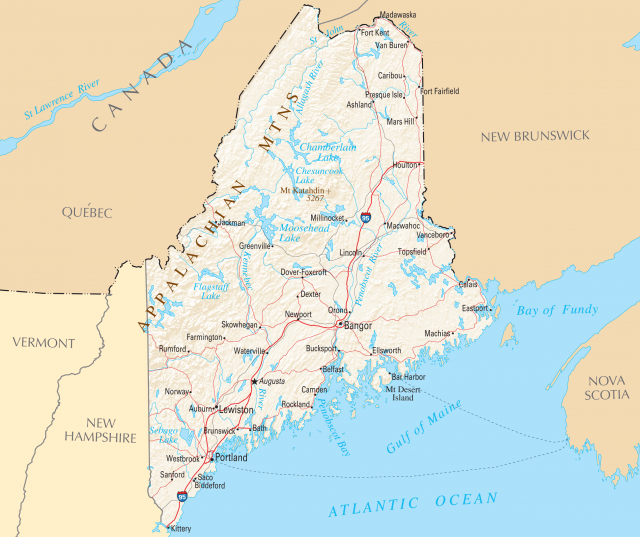The State of Maine
AT A GLANCE
Name: Maine probably comes from the word mainland. Early English explorers used the phrase “the main” to distinguish Maine from its offshore islands.
Nickname: Pine Tree State
Capital: Augusta
Size: 33,265 sq. mi. (87,727 sq km)
Population: 1,329,328 (2015 est)
Statehood: Maine became the 23rd state on March 15, 1820.
Electoral votes: 4 (2016)
U.S. Representatives: 2 (until 2016)
State tree: eastern white pine
State flower: white pinecone and tassel
State cat: Maine coon cat
Highest point: Mount Katahdin, 5,267 ft. (1,606 m)

THE PLACE
Maine forms the northeastern tip of New England and shares approximately half of its border with Canada. Maine's Atlantic coastline is famous for its bays, coves, and inlets. Most of the land along the shore is flat, but it gets higher in the central and southern regions of the state, which have areas of rich soil and good farmland. Maine's northwest is covered by the White Mountains, part of the Appalachian Mountain chain.
The northern and central parts of the state are dotted with ponds and lakes, and about 90 percent of Maine is forested. Maine produces many different kinds of minerals and mineral products, including limestone, granite, slate, copper, zinc, lead, sand, and gravel.
Because of its location on the northeast coast of the country, Maine is one of the coolest states. It lies to the north of where the Gulf Stream, a warm current of air from Europe, ends. As a result, Maine has cold, snowy winters and cool summers.
Facts and Firsts
- With a total land area of 33,265 square miles, Maine is larger than all of the other five New England states combined.
- Maine lies the farthest east of any state. Eastport is the eastern most city in the United States.
- Maine borders only one other state.
- Maine's Acadia National Park is the second most-visited national park in the United States.
- In June 1775, the first naval battle of the Revolutionary War was fought between the British and the American colonists off the coast near Machias.
- Maine produces at least 98 percent of all of the nation's blueberries, 50 percent of the nation's lobsters, and 90 percent of all the nation's toothpicks.
- In 1964, U.S. senator Margaret Chase Smith of Maine was the first woman ever to seek the presidential nomination from a major political party.
THE PAST
Historians believe that the Norse mariner Leif Eriksson and a group of Vikings explored Maine around A.D. 1000, a time when the only other inhabitants of the region were Native Americans.
The first true European settlement, however, did not begin until the 1620s, when different groups of English settlers moved into the region. In general, these settlers lived peacefully with the Native Americans, which included several Algonquian tribes.
In 1677, Maine became a part of the Massachusetts Bay Colony. Many Maine patriots fought in the Revolutionary War. In 1785, a movement began for Maine's separation from Massachusetts and admission to the Union, but it was not until after the War of 1812 that the movement gained strength. In 1820, Maine became an independent state as part of the Missouri Compromise. Maine entered the Union as a free state, while Missouri entered as a slaveholding state, thereby maintaining the balance of free and slave states in Congress. Maine strongly supported the Union cause during the Civil War.
After the war, Maine's textile and power industries began to develop, while small farms began to disappear. During the 1920s, the production of paper products from Maine's extensive forests became more important to the state's economy.
During World War II, Maine produced ships, shoes, and food for American troops. During the second half of the 20th century, tourism began to grow, as did the lumber and food-processing industries. Maine's growth was slowed during the 1970s and 1980s by overcutting in state forests and overfishing in its waters. Air and water pollution also became problems.
THE PRESENT
Maine is sometimes called Vacationland because of its popularity as a tourist destination. Maine's rugged coastline, historic lighthouses, scenic lakes, and White Mountains ski resorts attract millions of tourists every year. Paper production, electronics, and shipbuilding are also important industries.
Although agriculture declined in economic importance over much of the 20th century, Maine still produces one of the largest potato crops in the nation and more blueberries than any other state. Many farms also produce dairy products, including milk and cheese. Although pollution is still a concern, Maine residents are learning how to balance their industrial needs with the need to preserve their natural environment.
Born in Maine
- Dorothea Dix, civil rights reformer
- John Ford, film director
- Marsden Hartley, painter
- Sarah Orne Jewett, author
- Henry Wadsworth Longfellow, poet
- Stephen King, author
- Linda Lavin, actress
- Edna St. Vincent Millay, poet
- Marston Morse, mathematician
- Edwin Arlington Robinson, poet
- Margaret Chase Smith, politician